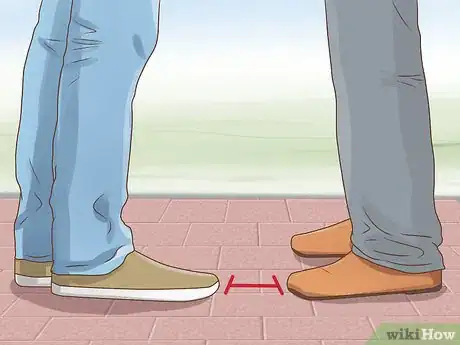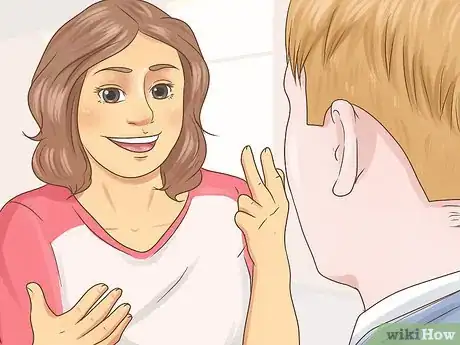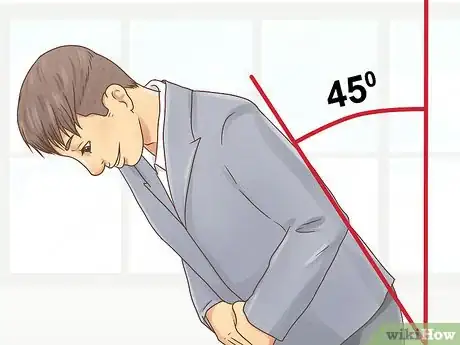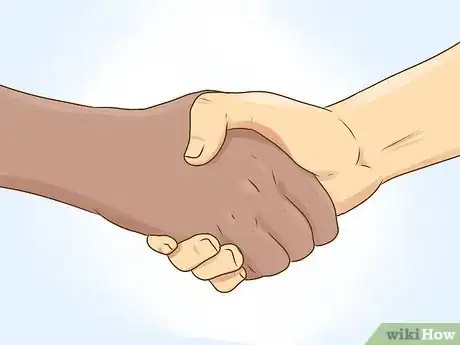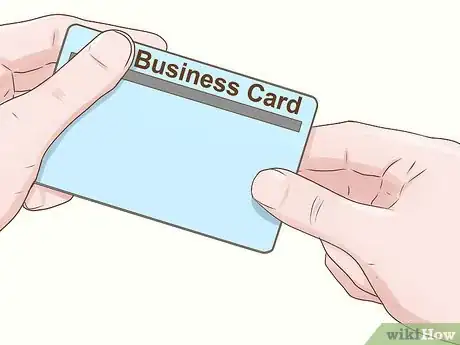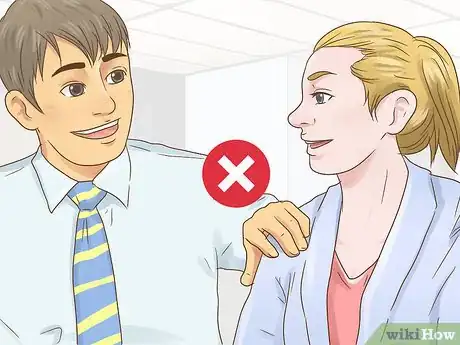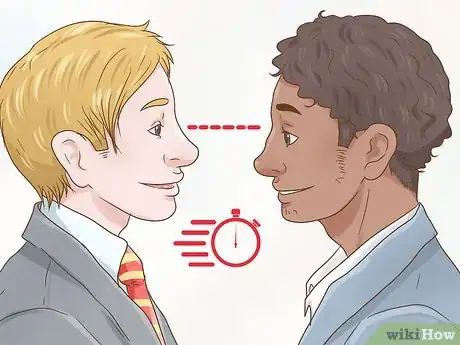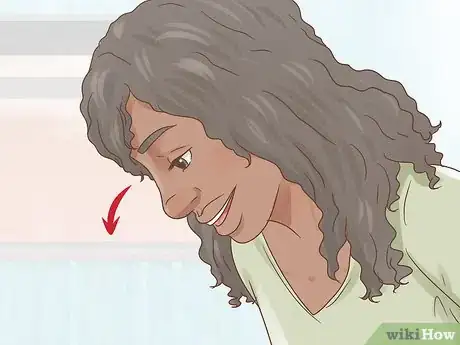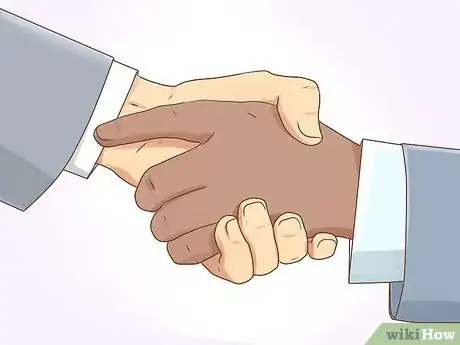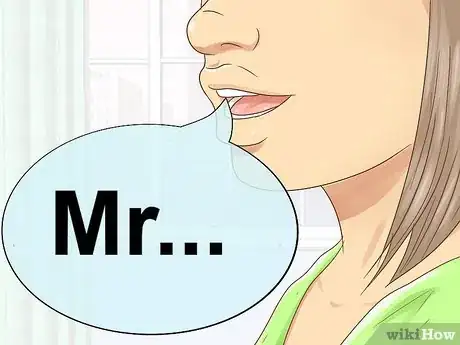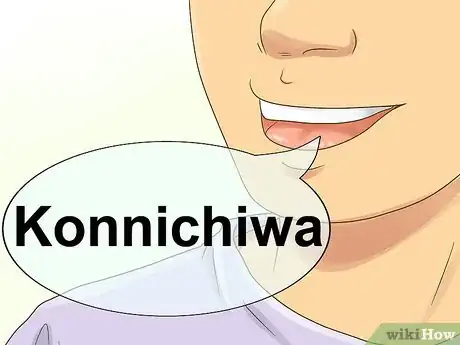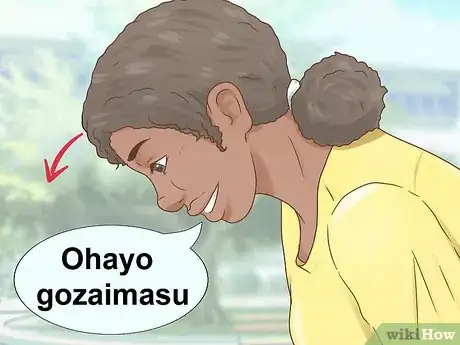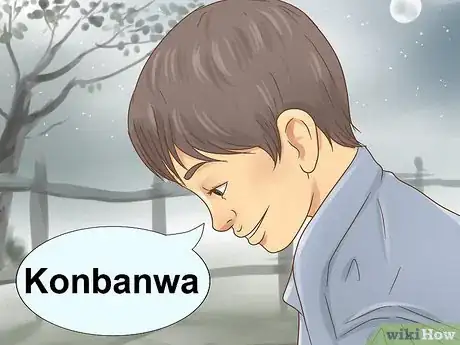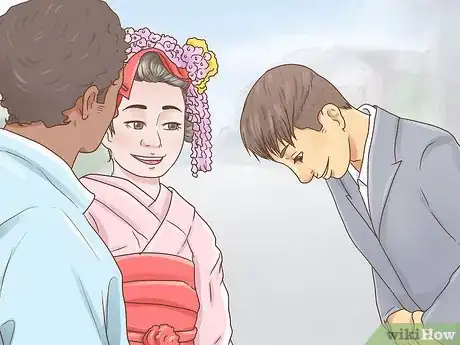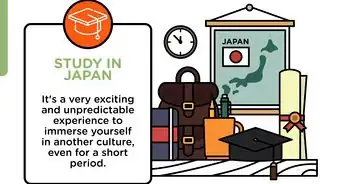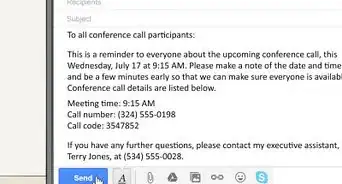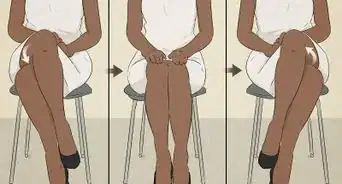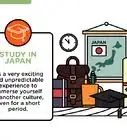This article was co-authored by wikiHow Staff. Our trained team of editors and researchers validate articles for accuracy and comprehensiveness. wikiHow's Content Management Team carefully monitors the work from our editorial staff to ensure that each article is backed by trusted research and meets our high quality standards.
There are 8 references cited in this article, which can be found at the bottom of the page.
wikiHow marks an article as reader-approved once it receives enough positive feedback. In this case, 82% of readers who voted found the article helpful, earning it our reader-approved status.
This article has been viewed 254,249 times.
Learn more...
Travel is a wonderful thing, but learning new customs can be tricky. A friendly gesture in one country can be outright hostile in another, so knowing your way around basic greetings is a must. If you are traveling to Japan, knowing how to greet others is a key skill. Fortunately, there are a few ways you can greet, ranging from the extremely formal to the more informal.
Steps
Greeting Formally
-
1Maintain distance. Do not step in for a handshake, a hug, or even a friendly clap on the back. Instead, maintain a respectful distance of several feet. Japanese culture values space and privacy, so make sure your body language reflects these values.
- Keeping two or three feet between you and someone else is a good rule of thumb. If you are further away, speaking and interacting may prove awkward or difficult.
-
2Be respectful. Speak distinctly but quietly, stay off of your cell phone in public spaces, and allow your hosts to take the initiative. Doing these things will demonstrate to your friends, hosts, or business colleagues that you are adaptable and value their cultural norms.[1]
- Boisterous and aggressive behavior are both considered disrespectful. Be kind to any vendors or service people you come across.
Advertisement -
3Keep your gaze lowered. Bold eye contact is considered quite rude, so keep your eyes averted whenever possible. Although you do not have to stare at your feet, try to watch someone’s mouth while they talk, or their chin. Avoid heavy eye contact, as this can appear aggressive and inappropriate.[2]
- Practice avoiding eye contact in the mirror by talking and watching your mouth, or in interactions with people from your home.
- This rule may be lax in some areas of Japan, or among younger crowds.
-
4Bow from the waist to a 45-degree angle. Hold your bow for between two and five seconds, keeping your hands near your hips or thighs. The more respect you wish to convey, the deeper your bow should be.
- You can also bow with your hands pressed together near your heart.
-
5Shake hands, if offered. Although you should never initiate a handshake, you can accept one. Touching in general is considered somewhat taboo in a formal situation, so a handshake should only be engaged in if the person to whom you are speaking begins the contact.
-
6Provide your business card. In Japanese culture, exchanging business cards is an important aspect of communication. To properly offer your business card, extend your card with both hands, preferably with Japanese writing on the side of the card facing your colleague.[3]
- To accept a card, take the card with both hands and bow to indicate your appreciation.
- Business cards are exchanged from the most prestigious person to the least, so do not offer your business card before your superiors have.
Greeting Informally
-
1Avoid direct contact. Even if you feel comfortable with physical affection or physical demonstrations of familiarity, do not assume that the people around you feel the same way. Even in informal situations, stick to a simple bow and maintain a healthy distance.[4]
- This is particularly important as people of different sex and gender identifications as it maybe be considered inappropriate and impolite to exchange physical contact in public, not because of queer identification, however, because traditionally on a binary system individual of different sex/gender identification do not engage in excessive physical contact.
- If you have a close relationship with the people with whom you are interacting, you may be encouraged to demonstrate more familiarity with them. Follow the lead of those around you.
- There is a growing awareness and acceptance of the LGBT+ community in Japan as such, traditions and customs are evolving.
- 中性/intergender [Chuu-sei]
- 両性/bigender [Ryo-sei]
- 無性/agender [Mu-sei]
-
2Hold only brief eye contact. In more informal situations, you can make eye contact, but do not hold it for an extended period of time. Instead, allow your gaze to linger for a matter of seconds before moving to another focal point.
- Follow the lead of the person with whom you are associating. If they do not initiate eye contact, you should follow suit.
-
3Give a small bow or dip of the head. Even in informal situations, you should offer a bow as a form of greeting. The depth of your bow will determine how much reverence or respect you are offering, so a small bow from the waist or a gentle dip of the head will suffice for an informal setting.[5]
- If you do not know the people to whom you are bowing, engage in a more pronounced bow and reserve gentle nods for acquaintances or known colleagues.
-
4Shake hands. In an informal setting, feel free to offer up a handshake, but do not be too firm or aggressive. Instead, keep your hand loose.[6]
- Handshakes are also not held as long in Japan as they might be in Europe or the United States. Rather than holding a firm handshake for ten seconds or more, grasp hands for a maximum of five seconds before letting go.
-
5Offer a smile. Large displays of emotion are not common in Japanese culture, so don’t be surprised if you do not encounter a lot of friendly smiling. If you are familiar with someone, however, don’t feel you have to shy away from smiling or grinning.
Greeting With Common Japanese Phrases
-
1Address using their formal name. In public, you should expect to greet people by their family names, rather than their first names. Using first names is considered far too familiar in a public setting, and may cause confusion or upset.
- If you aren’t sure what to call someone, ask! Addressing someone incorrectly is far ruder than asking for clarification.
-
2Say “hello” with a simple, “Konnichiwa.” This is a simple, straightforward greeting that means “Hi” or “Good day.” Appropriate for strangers and friends alike, this is the “one size fits all” of Japanese greetings, and is the safest go-to.[7]
- When in doubt, use this phrase. It is easy to pronounce and can be used anywhere, with anyone.
-
3Bow and say, “Ohayo gozaimasu” in the morning. Translated as, “Good morning,” “Ohayo gozaimasu” is a wonderful way to greet someone formally in the morning. You can use this phrase for everyone, from the person working at the front desk of the motel, to your friends and acquaintances.[8]
-
4Bow along with a “Konbanwa” in the evening. Pairing with the aforementioned step, greet people with “Konbanwa” in the evening. Although it may seem unnecessary, the formal nature of Japanese culture encourages a formal greeting any time of day. Don’t be afraid to “overdo” it when it comes to greeting those around you.
-
5Address everyone in a group. While a single greeting satisfies many cultures for a group of people, Japanese culture dictates that you address everyone in a group individually. If you encounter a group of three people, for instance, it is proper to bow and speak a greeting three times, turning to face each person in turn.
- This may seem awkward at first, but will become easier as you practice. If you have trouble, practice at every available opportunity. It will eventually become second nature.
Community Q&A
-
QuestionIs it important to keep a certain distance from the person I am greeting?
 Community AnswerThe distance between your feet and theirs should be around two or three feet.
Community AnswerThe distance between your feet and theirs should be around two or three feet. -
QuestionI will be meeting my son's female Japanese teacher for the first time in teacher/parent interviews. How should I greet her and should I bow?
 Community AnswerYou should say: Ohio go-zai-mas, and then bow. That is the formal greeting in Japan. Just say Ohio like you would say the state Ohio.
Community AnswerYou should say: Ohio go-zai-mas, and then bow. That is the formal greeting in Japan. Just say Ohio like you would say the state Ohio. -
QuestionI am from the UK and will be meting my son-in-law's parents in Japan for the first time. How do I greet them?
 Community AnswerIf you are meeting elders or family in Japan, I would recommend a slight bow and a hello. Introduce yourself by your full name. Bow at either a 15 degree angle or 30 degree angle.
Community AnswerIf you are meeting elders or family in Japan, I would recommend a slight bow and a hello. Introduce yourself by your full name. Bow at either a 15 degree angle or 30 degree angle.
Warnings
- Pay attention to your body language. Do not show the sole of your foot, point with your finger, or maintain strong eye contact. All of these actions are considered extremely rude.⧼thumbs_response⧽
- Do not attempt to breach the customs on your visit to Japan or with a Japanese friend. Follow the lead of others.⧼thumbs_response⧽
References
- ↑ http://factsanddetails.com/japan/cat18/sub116/item611.html
- ↑ http://www.ediplomat.com/np/cultural_etiquette/ce_jp.htm
- ↑ https://blog.gaijinpot.com/exchanging-business-cards-japan/
- ↑ http://sharonpluralism.org/cultural-protocols/japanese-culture/
- ↑ http://www.spiritualresearchfoundation.org/bowing-greeting
- ↑ http://www.worldatlas.com/articles/guide-to-japanese-etiquette.html
- ↑ http://www.dummies.com/languages/japanese/japanese-greetings-and-good-byes/
- ↑ https://www.rocketlanguages.com/japanese/learn/japanese-greetings
About This Article
If you’ll be traveling in Japan, you’ll need to know how to greet people both formally and informally. For a more formal greeting, keep 2 to 3 feet distance between yourself and the other person to show respect. You’ll also want to speak in a quieter tone and keep your gaze lowered to show an appreciation for cultural norms. Bow from the waist to a 45-degree angle, shake hands if offered, and present your business card to complete your greeting. For a less formal greeting, stick to a simple bow and maintain a healthy distance. While you can feel freer to make eye contact, only hold it briefly. Whether the greeting is formal or informal, in pubic use people’s family names rather than their first names. For a simple “Hello,” say “Konnichiwa.” If it’s morning, say “Ohayo gozaimasu,” or try “Konbanwa” for an evening greeting. To learn how to greet everyone in a group, keep reading!
